Li-lan
Carter Ratcliff
Silent Journey – Jason McCoy Inc. Exhibition catalogue, New York, NY
March 2006
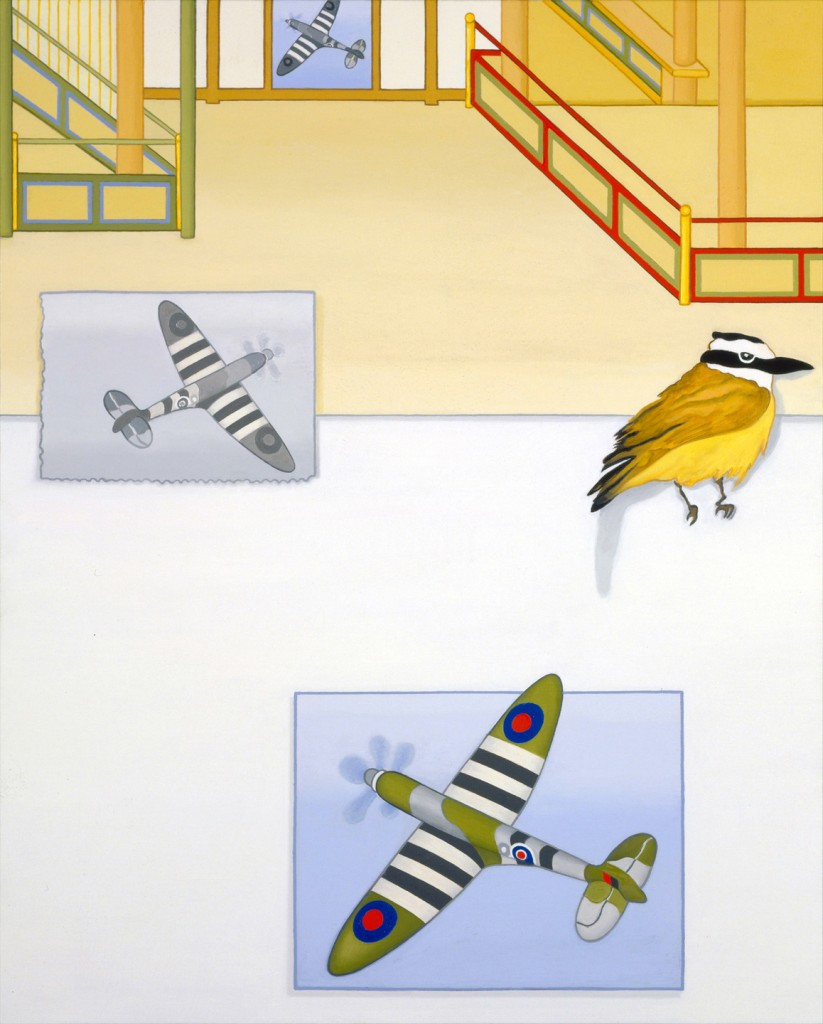 Flycatcher – 2005
Flycatcher – 2005
Li-lan’s Flycatcher, 2005, is named after the small bird perching on an invisible branch near the right-hand edge of the painting. The creature’s body is two shades of beige and its head is marked with black and white stripes very like the ones on the wings of the airplane that appears once in the foreground, again in the middle ground, and a third time in the background of this painting. In Silent Journey, 2005, the wings of the ascending aircraft-real or a toy?-share an angle with the legs of the bees levitating nearby. In other paintings, the curve of a cicada’s wing rhymes with the surge of a wave and the outline of an envelope echoes that of the stamp it bears.
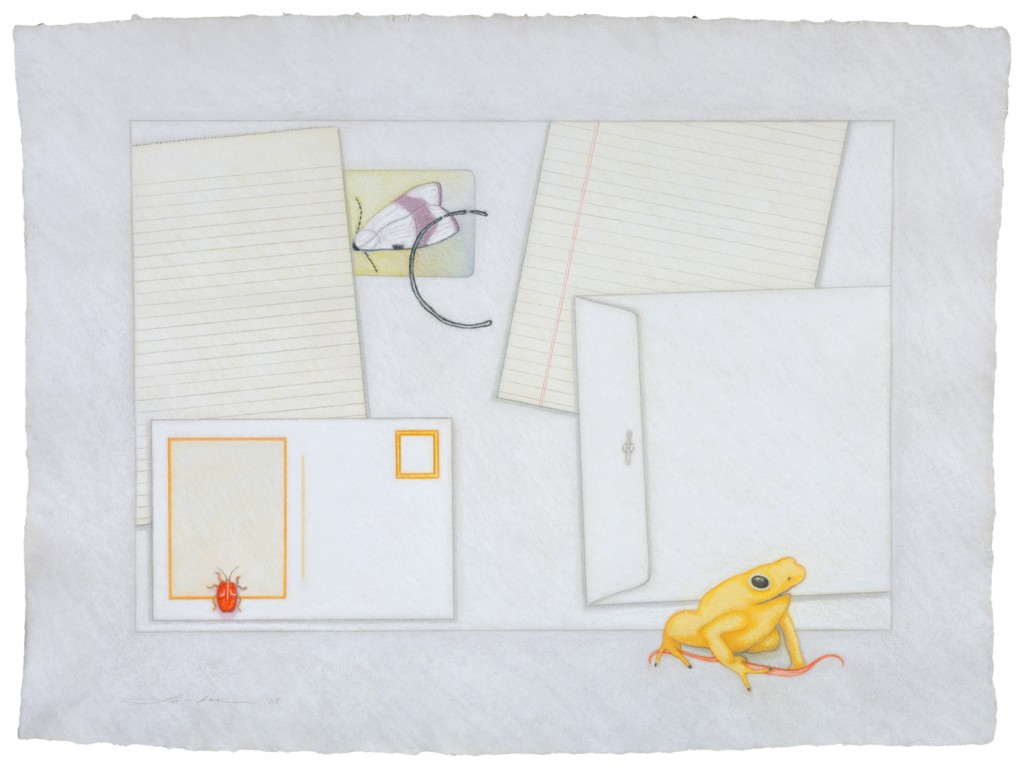
Tittle-Tattle – 2005
With stamps and envelopes and other flat, rectangular motifs-see, for instance, the legal pads in Tittle-Tattle, a pastel painting from 2005-Li-lan reiterates the flatness and rectangularity of the canvas with a clarity that brings to mind the grid. When her envelopes overlap they recall collage, and of course her glowing fields of white allude to another device of modernist painting: the monochromatic field. Monochrome is sometimes a means to a literalist end, a way of insisting that a painting is a physical object. This is a point Li-lan has no reason to deny, yet she never presents the surface simply as a surface. Her expanses of white attract the eye to their textures, the almost invisible textures of her brushwork. Tracing the energies of her hand, one is drawn into regions far beyond the physical surface of the canvas.
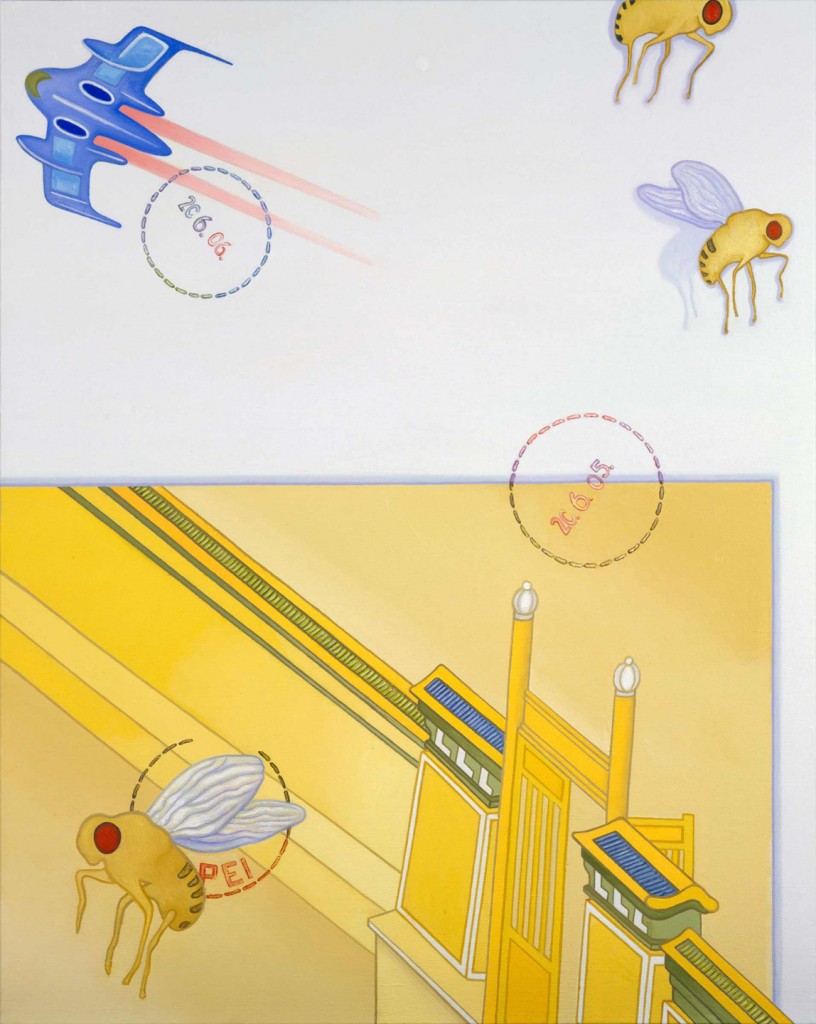
Silent Journey – 2005
These are the depths the airplane in Flycatcher enters by repeating itself three times, getting smaller as it goes. One thinks of perspective and then one sees a kind of perspective in the woodwork of Flycatcher, as in the angled wall of Silent Journey, 2005. Yet Li-lan is not a perspectivist any more than she is a literalist, which is to say that she doesn’t assert imaginary spaces any more than she denies them. Mixing assertions with denials-fragments of perspectival systems with literalist bits and pieces-she induces a lively sort of trance.
The details of her paintings fascinate, and their connections deepen the fascination. In Flycatcher, black and white stripes are shared and so is the form of a circle, which appears as the bird’s eye and then reappears as insignia on the wings of the thrice-repeated airplane. Two instances of circularity plus two kinds of flight: avian and aeronautic. Following this pattern of theme and variation into the architectural zone of Flycatcher, one notices that the railings fly through space on a trajectory parallel to direction taken by two of the three planes. Everything in the art of Li-lan is either flying or poised for flight or, at the very least, afloat on waves or in expanses of white that look like fragments of a boundless luminosity.
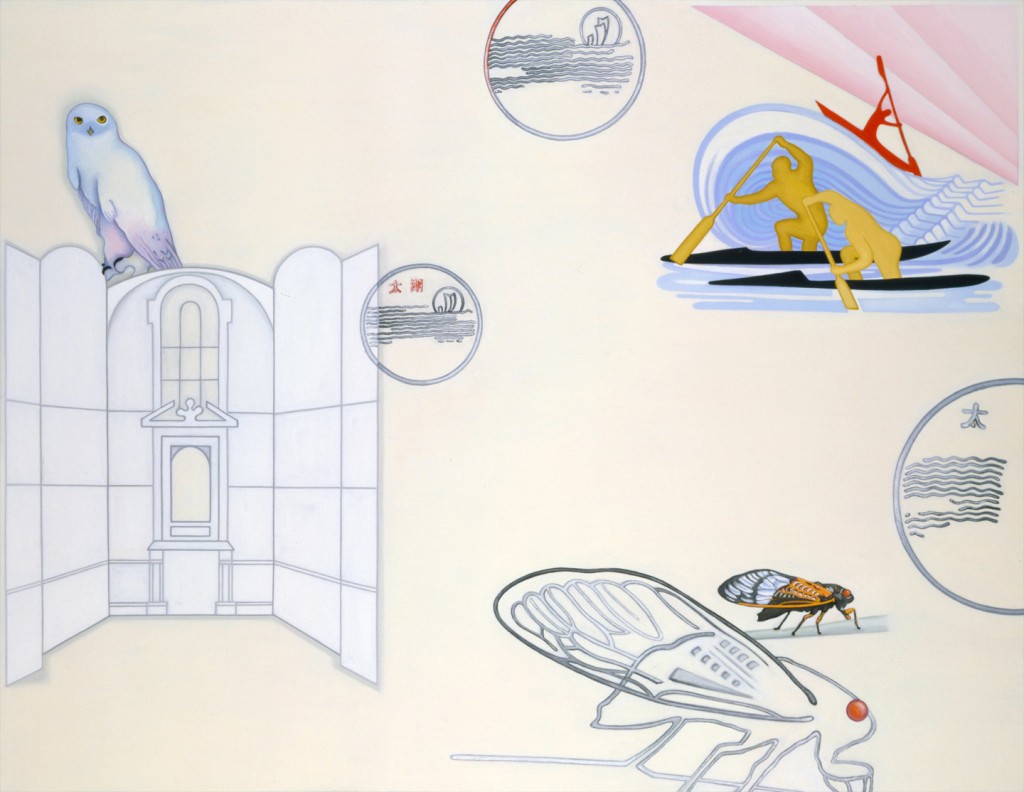 Sea of Silence – 2005
Sea of Silence – 2005
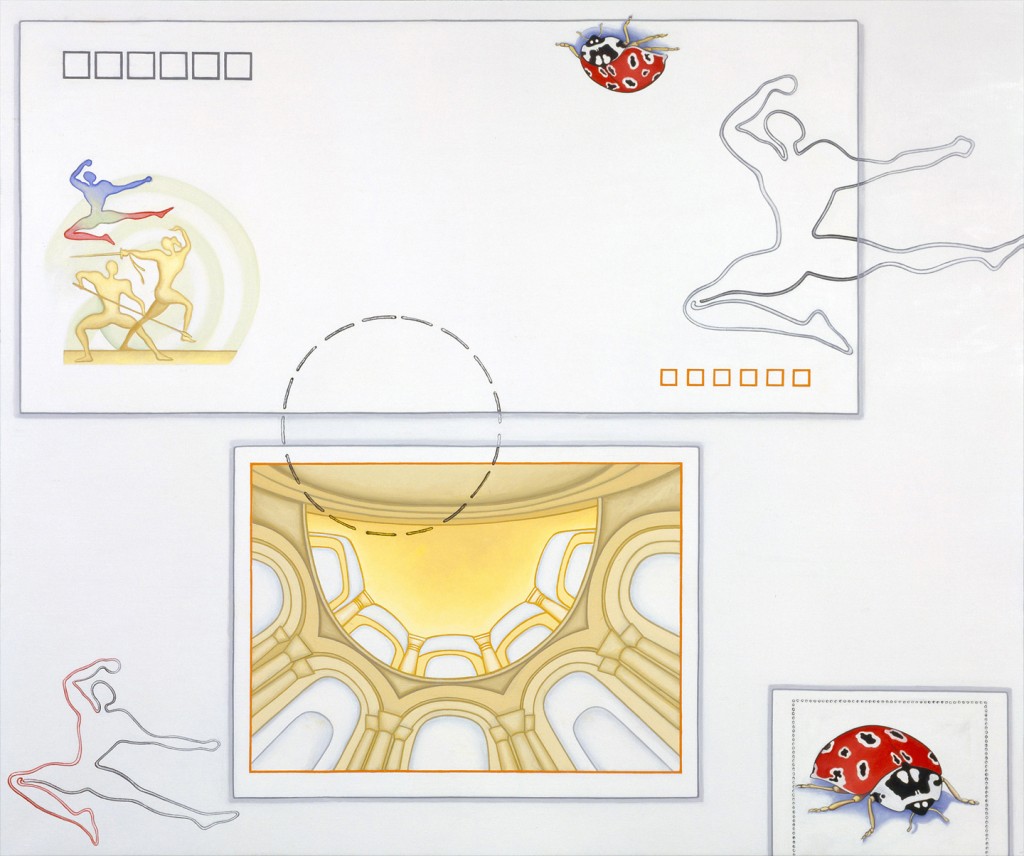
Fable – 2003
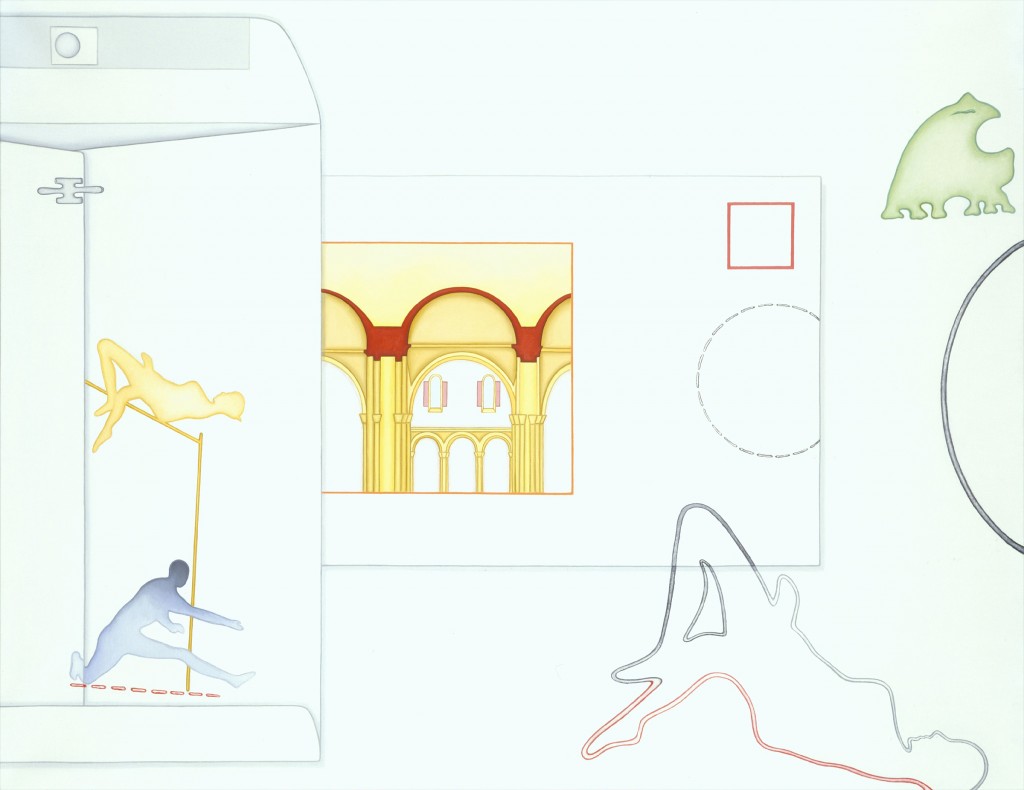
Legend – 2003
In Li-lan’s light, buildings do not enclose space. They merge with it. The apse in Sea of Silence, 2005, is all outline, as transparent as the wings of the nearby cicadas. Here, architecture looks less substantial than the full-color cicada and no more so than the mysterious stamps that drift over the surface, intersecting delicately with other motifs. Within the circles of those stamps are patterns with a resemblance to the schematic waves where canoeists ply their paddles in silhouette. There are further echoes to be traced in this painting-see the curve of the owl’s skull and its reiterations, exact and subtly altered, elsewhere in Sea of Silence. Moreover, this painting’s images resurface, transformed, in other paintings. The canoeists, for example, are fencers in Fable, 2003, and high jumpers in Legend, 2003. Always, forms soar or fly or glide-or, in the case of an airmail stamp, there is an implication of flight.
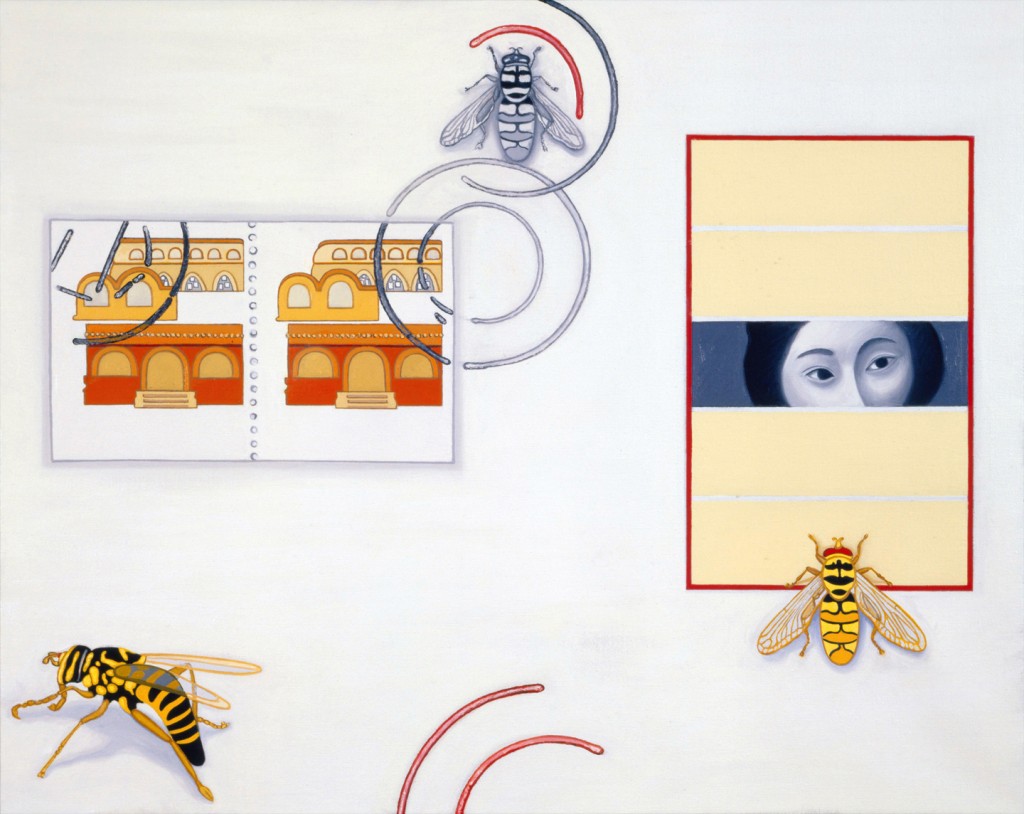
Look Out – 2004
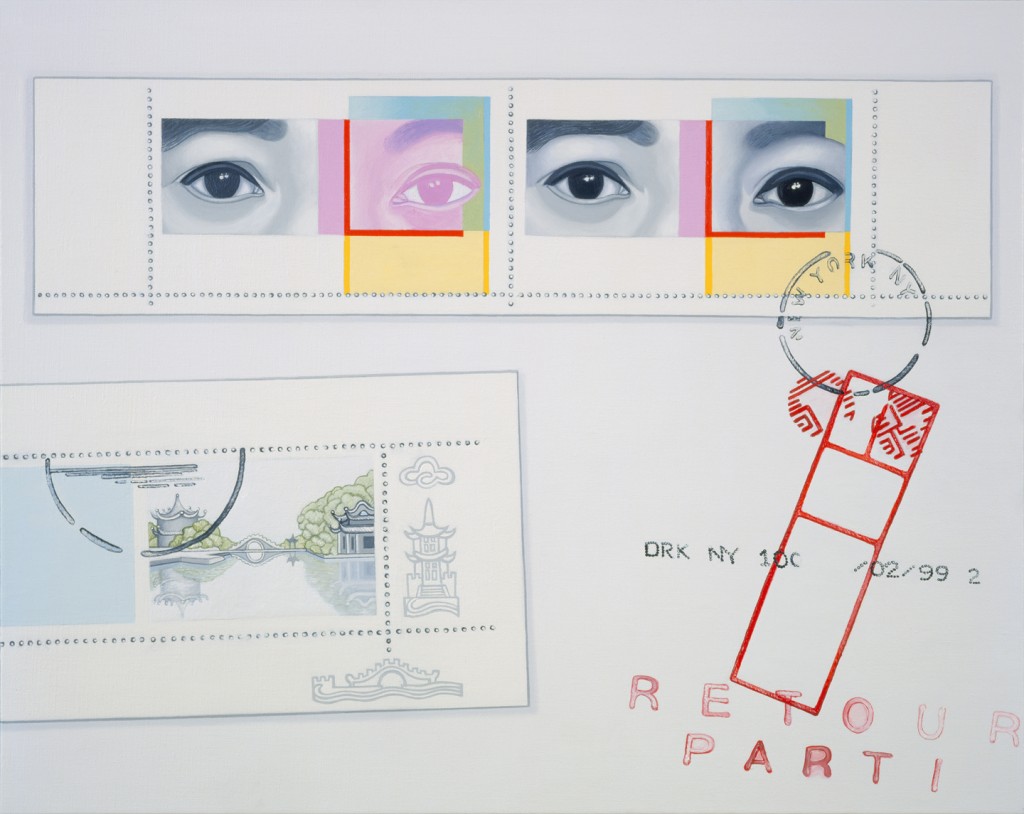
Chinese Bridge – 1999
Of course, variations of form and theme are not in themselves the point. So it is not enough to note that Look Out, 2004, is a play of circular and squared-away motifs. We have to say more-something about visual rhythms, possibly, or a pictorial equivalent to magnetic force. For this is the force that generates the rhythms. What I’m getting at is the way Li-lan endows each of her motifs with what might be called a charge of affinity. Sharing a ghostly gray, one of the bees and several of the circular lines in Look Out have floated into a taut pattern near the upper edge of the painting. The gray lines curve like cancellation marks over the stamps, with their doubled image of ochre architecture. Curves fill this image, as well, and we might imagine that one of them has migrated from its source, aggrandizing itself in the process, to join the pattern of gray bee and gray lines. A warm, rich color, this rusty circle has the power to call up echoes of itself at the opposite edge of the canvas. And it lends its hue to the frame around the image of a face (the artist’s schematic variation on a more literal self-portrait in an earlier painting, Chinese Bridge, 1999), which is yet another set of curves. Throughout the painting, modulations of this color-from dusty yellow to rusty brown-keep everything at once connected and distinct.
Or so it seems plausible to argue, though no argument, properly so-called, can have any real grip in the realm of the visual. When I talk about the formal and thematic affinities that bring Li-lan’s images to rest in certain configurations I am not doing the sort of thing that a physicist does. I am not charting actual fields of force. I am deploying fictions in the hope of pointing the way past language to the pictorial strengths and richness of Li-lan’s art. To say that something like magnetic force sends her images in orbit around one another is to encourage viewers-myself, first of all-to sense the give and take, the balance and counter-balance, that produces the final configuration of a painting. This is a matter of composition, not as a formal exercise guided by principles but as an artist’s means to a resolution of feelings. Of course, we are no longer much in the habit of talking about pictorial composition.
First the sprawl allover painting and then the symmetries of Minimalism distracted critics from the compositional concerns that preoccupied them for centuries. Yet the idea of successful composition, the harmonious arrangement of disparate parts, still haunts us. We still know what it means to say that an image clicks or, less casually, to declare that a compositional decision looks inevitable. Entangled with notions of transcendent beauty, composition often leads to invocations of the inevitable, the absolute, the necessary. Those looking for necessity in the art of Li-lan will find it in the order that fills the blank spaces of her canvases with a serene sort of tension.
Those who prefer contingency to necessity-open systems to closed systems-will find it in the beautifully calibrated tenuousness of her compositional order. Every image in her oeuvre seems to have entered into a thoroughly transient relation with every other image, so that certain sympathies can be seen or sensed. In a moment, every form and motif will sail off in its solitary orbit. Or that is how it looks to me, for I see the coherence Li-lan’s paintings as exhilaratingly fragile. Each of her motifs seems to have traveled a long way to arrive at the point where it becomes visible to us, like a plane making a scheduled landing or a letter finding its recipient.
Though I understand Li-lan as an allover painter who keeps the edges of her canvases permeable, I don’t say it is wrong to see her as a proponent of compositional closure. Interpretations do not come in opposed pairs-one right, the other wrong-and there is no denying that powerful traditions encourage us to see a picture’s elements as securely contained by its frame. Nonetheless, the energies of Li-lan’s art have the feel of vectors: trajectories with no reason to stop at the edge of the canvas. In her geography, a frog’s leap is equal to an air liner’s intercontinental flight.
Not that Li-lan shows any frogs in mid-jump. The ones in the Tittle-Tattle pastels rest quietly in the lower right-hand corner of the paper. Their leaps are sheer potential, as are the itineraries of the airplanes she finds suspended in virtual space on stamps and airmail stationery. It is crucial to note the obvious: Li-lan deals in pictures-rather, in pictures of pictures. Some of these she finds in her trove of personal memorabilia. Others she gathers ready-made from the flood of imagery that comes to us by way of the postal service, magazines, books, and brochures. Weightless chunks of architecture, symbols of flight, envelopes and stamps: any of these can trigger a specific memory or prompt sweeping ruminations on travel, communication, or memory itself.
In Legend as in other recent paintings, the arc of a half-circle acquires the look of a solid premise by serving as an architectural element. Arc becomes arch, geometric form becomes palpable-in imagination, anyway-and a series of variations is launched, as high jumpers arc over the bar, their legs forming arches as they reach the highest points of their trajectories. But this is to talk about only visible forms. Legend takes its scale from the virtual lines, the invisible arcs, that connect its various motifs, and that scale is vast. As I suggested earlier, Li-lan’s postal imagery opens the space of her paintings to our recollections of intercontinental travel-the pleasurable not the practical kind, and the pleasures of a painting like Legend are akin to those of a long journey, recollected or imagined.
Traditionally, critics have praised artists for providing pleasure. Some echo the ancient idea-enunciated by the Roman poet Horace, among others-that art should begin in delight and end in wisdom. A painting succeeds if it pleases and instructs. Modern aesthetics was launched toward the end of the eighteenth century with the argument that the pleasure of true art is unalloyed. Didactic purposes are to be excluded so that, as Kant put it, the mind can give itself over to “the free play of the cognitive powers.” With moral and practical concerns suspended, this play harmonizes all our faculties with each other and with the object of contemplation. In that harmony is a pleasure absolutely pure and specific to aesthetic experience.
Later writers revised Kant with great sophistication, and even if the doctrines of the aestheticians are rarely consulted these days, we are all heirs to the idea that we enjoy some pure-or at least self-justifying-pleasure whenever we truly get a work of art. That idea is presupposed by all my comments about the calm exhilaration to be felt as one traces the patterns of theme and variation in Li-lan’s art. Yet I don’t think this idea is entirely adequate-not that I want to reintroduce the notion that art should instruct as well as please. I don’t admire Li-lan’s paintings because I have figured out a way to extract didactic axioms from them. It might be mentioned, however, that much criticism of the past three decades or so has treated art as a source of moral lessons-a bad policy, for it reduces painting to an illustration of points better advanced with straightforward prose. Yet the idea of art as a source of pure pleasure is also dubious, for it turns paintings into refuges: escape hatches from the ordinary world. A richer sort of pleasure would return us to that world.
This thought occurred to me when I realized that following the trajectories of Li-lan’s imagery is not an exercise in purely pictorial analysis. Engaging me much in the manner of seductive narration, the vast patterns of her pictures put something at stake that reaches beyond the limits of the aesthetic, strictly defined. Of course, I am not saying that she is a storyteller any more than I am calling her a moralist. Rather, she maps the possible connections between things with a subtlety and wit that brings me alive to the paths I follow from point to point, thought to thought, feeling to feeling. Making sense of Li-lan’s paintings, I realize that, as suggestive as any one of her motifs may be, the vectors connecting them are more so, for they guide us to a sense of what it is to make sense of things-to intuit the incessant play of similarity and difference, of the familiar and the new, that is basic to the possibility of anything having any meaning at all.
Because visual art is beyond words, it hands us nothing in the form of a statement. But this is not to say that the meanings of art are vague. What’s vague, for example, is the everyday intuition of the interconnectedness of all things. Li-lan’s luminous art makes it precise and vivid. So does the art of William Blake, with its densely intertwined anatomies. Early in the previous century, collage did the same, defeating the fragmentation of its forms with the unities of its compositions. If all things are connected, all visions of that connectedness are included in the network of meanings, and there is pleasure to be felt at every point in the pattern. Or the pattern weaves itself as one notices how a work of art hangs together and thus invokes the world in full, as Li-lan’s paintings do, as much with blankness as with images. This, I believe, is the point of her art: to guide us, with allusive economy, toward an inkling of all that is and a feeling that the existence of each thing depends on its link to everything else.
Carter Ratcliff is a leading art critic and contributing editor of Art in America. He has received numerous awards of distinction for his work, including the College Art Association’s 1987 Frank Jewett Mather Award for Art Criticism, a Guggenheim Fellowship, two national Endowment for the Arts’ Art Critics Grants, and a Poets Foundation Grant. His writings have appeared in American and European journals and in the publications of museums including the Museum of Modern Art in New York, the Guggenheim in New York, and the Royal Academy in London. He has taught at the School of Visual Arts and Hunter College and has lectured at a variety of institutions, including the Whitney Museum of American Art and the San Francisco Museum of Modern Art. He is the author of a collection of essays, The Figure of the Artist (2000, Cambridge University Press), and The Fate of a Gesture: Jackson Pollock and Postwar American Art. He lives in New York City.
